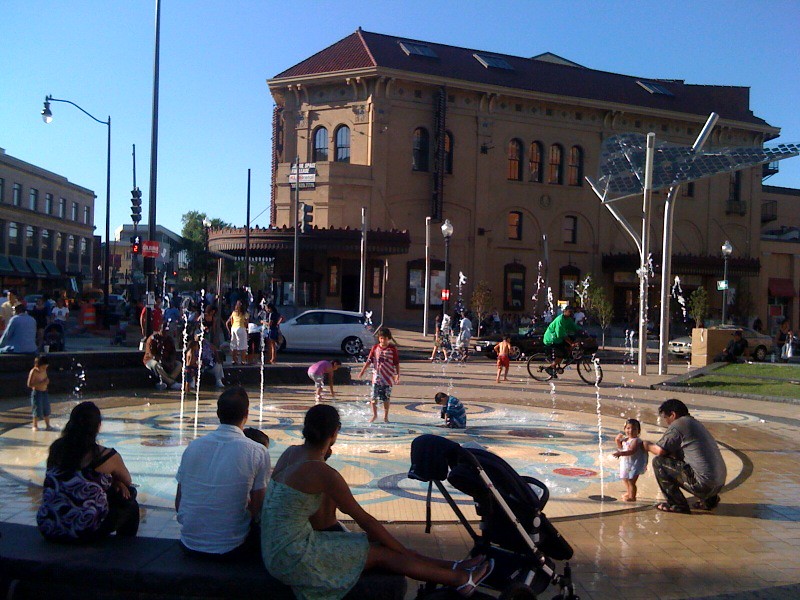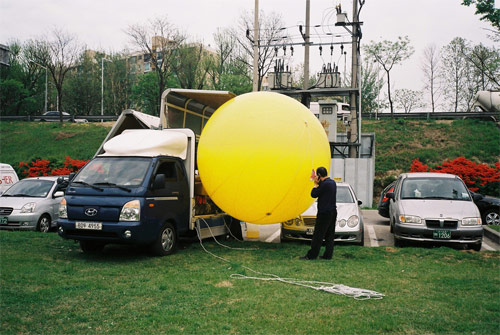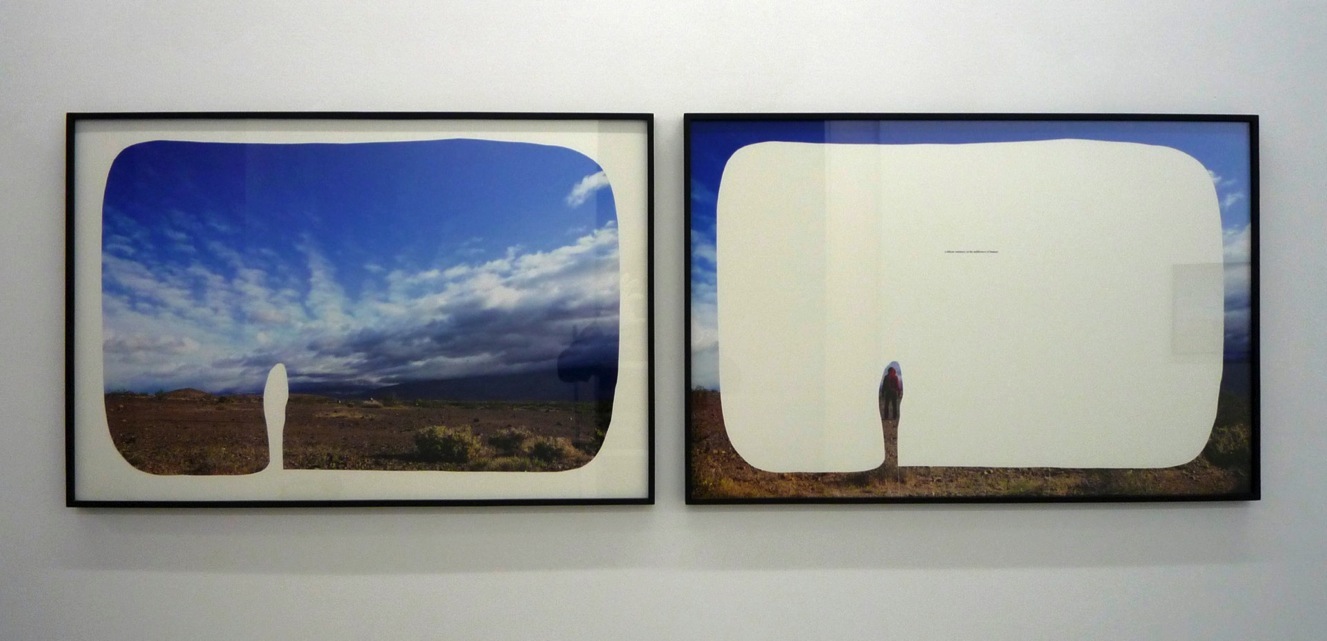
Love this project, Hacking the City, an experimental exhibition curated by Museum Folkwang. Ends September 26, 2010, so check it out now.
Thanks Lisa!
7.28.2010
Hacking the City
Posted by Shin-pei at 10:07 AM 1 comments
7.25.2010
Perceptions of change: streets, buildings, neighborhoods

The water feature in the new plaza in Columbia Heights at 14th St NW and Park St only gets busier as the night goes on.
By some amazing serendipitous twist, I had the pleasure of staying last week with a writer who has worked in the community development, historic preservation, transportation, and public space arena. We got to talking about her neighborhood, Columbia Heights, which has gone through a lot of change in the last few years. A fascinating conversation, in that it underscored just how much context and firsthand experience of living through change informs our lens when deciding the type of change we want with our spaces.
Columbia Heights was recently rezoned, and instead of bundling the parcels for one developer, the local community development corporation decided to put each parcel out so that several developers would have a hand in the corridor. Having lived with the longstanding Atlantic Yards project in Brooklyn, this strategy didn't sound off any alarms for me. Different developers seemed to reduce the risk of a monolithic perspective dominating the area. Lisa had a another perspective: with so many developers weighing in on the neighborhood, cohesiveness was eroded and the opportunity to contextualize the new developments with the surrounding community was lost. No judgment here, the merits of this perspective are pretty clear.
The second differing opinion had to do with the design of the Dance Institute of Washington's new building. I had walked by it a few times and liked how it allowed pedestrians to see what was going on inside, a greater emphasis of opening up the studio to the neighborhood. 
The dance studios for the Dance Institute of Washington are transparent to the users of the street below.
This corner of a rehearsal studio in the redesigned building in Lincoln Center allows passersby to get a glimpse of the dance students.
My positive impression was perhaps largely informed by my habit during college of walking by the performing arts building on my way home after a long day. It was lovely to see the dancers working at the barre after spending hours studying in the stacks. As a mom, Lisa was concerned about the experience of the kids; me without kids, this perspective was simply not available to me.
In spite of our differing opinions, we had a great conversation about the neighborhood. Or perhaps, because of our differing opinions, we did. She helped me understand another way of looking. And it reminded me that we're constantly writing and re-writing the narratives for our neighborhoods.
Posted by Shin-pei at 1:20 PM 2 comments
7.21.2010
Next Planning Corps - July 28

photograph by Nina Ahn
Yo yo yo, it's that time again. Planning Corps meets once a month (usually at the end) and is a way for planners to geek out, meet other planners, share a beer, and all in the act of advancing a non-profit's cause. Thank goodness for Planning Corps - a lifeline for me! A chance to apply planning at a local scale, always good for the brain, heart, and soul. We've been working on Queens Boulevard, public plazas, citizen engagement, and mapping neighborhoods. Unless otherwise posted between now and then, the next session will be at the Open Plans penthouse, 148 Lafayette at 6:30, Wednesday, July 28. Check the site for an agenda (should be up soon) and see you there!
Posted by Shin-pei at 4:30 PM 0 comments
New news

"the insistence of distance" by Richard T. Walker via vvork
When I told a friend that I recently joined the Carnegie Endowment, his response was, so you're leaving planning? That's an emphatic NO. (Someone else asked me how I could choose between bike lanes and world peace.)
At face value, I get what he's suggesting. No more sketching out re-designs for street intersections, fewer opportunities to examine maps, plans, surveys, reviewing EIS, and facilitating workshops.
But at another level, I think planning is about chipping away at things and arriving at land use and transportation policies - all part of the larger built environment policy family - that promote better strategies for the way we want to live and for how we can secure a positive future. The issues that concern us as planners are very connected and operate at many scales, including national and global. Does this really need to be said again? More on my project soon, with a project site to be launched this fall. In the meantime, I'll still be posting about public space (big and small) items here, and will also be continuing to work on Planning Corps which you should totally check out in person if you haven't already.
Posted by Shin-pei at 2:40 PM 1 comments
Lots being done...

Very fun going through the index of Project M:
Project M is an intensive summer program designed to inspire young graphic designers, writers, photographers and other creative people that their work can have a positive and significant impact on the world.
Posted by Shin-pei at 2:36 PM 0 comments
7.08.2010
Ideas for shifting American Dream

"Housing Development at Different Stages, Las Vegas, NV, March 2005" by Alex Maclean at the jen bekman gallery
...that's right, suburbs! The finalists from Build a Better Burb competition are up, and the People's Choice vote is open till October 4. Love that this competition merges planning and design thinking.
I recently spent some time in suburbs myself and personally dislike (verging on hate) the experience, but am endlessly fascinated by how people LOVE living in that environment. Visiting is one thing, but living? That's all I can think of when we drive through the endless streets of detached houses located a drive away from anything else - people love living like this. It's truly a dream come true for many.
But when you piece together what they go through to live this dream, it seems to be a huge hassle and expensive too. On an individual level, I guess people like choosing the hassles they're willing to live with. On a community level though, the multitude of individual choices just don't mesh well, never mind the long-term problems with supporting developments of this type...and on and on. So these competition ideas each have great potential, each a creative spin on some au courant planning basics. There were only a few out of the 20 odd finalists that dealt more deeply with regionalism.
Postscript: I had a suspicion I've written about the American Dream before, the immigrant experience seems to frame things in a way that's unavoidable for me: how a city in another country thinks about its life dreams, how housing development companies capitalized on the american dream and then on the disillusionment with this dream. Whoa.
Posted by Shin-pei at 11:32 PM 0 comments